Navigating Troubled Waters: Optical Technologies in Anti-Piracy Efforts
12th Feb 2024 Numerous vulnerabilities and hazards exist when at sea. From being swept overboard and encountering severe storms to fires, restricted access to medical care, long hours and exhaustion, working at sea poses many risks and dangers that aren’t typically found in land-based jobs. Furthermore, the presence of maritime criminal activities intensifies threats, often escalating into perilous encounters. Here, we explore contemporary technological advancements and strategies implemented on ships to thwart piracy raids.
Numerous vulnerabilities and hazards exist when at sea. From being swept overboard and encountering severe storms to fires, restricted access to medical care, long hours and exhaustion, working at sea poses many risks and dangers that aren’t typically found in land-based jobs. Furthermore, the presence of maritime criminal activities intensifies threats, often escalating into perilous encounters. Here, we explore contemporary technological advancements and strategies implemented on ships to thwart piracy raids.
The harrowing cinematic adaptation of the 2009 MV Maersk Alabama hijacking in the Tom Hanks blockbuster Captain Phillips vividly illustrates just how terrifying it can be when pirates seize cargo ships. Fortunately, for many onshore the anxiety experienced while watching the movie dissipates with the rolling of the credits. Yet, for merchant sailors, this unease remains a concrete and everyday reality.
The Current Seascape
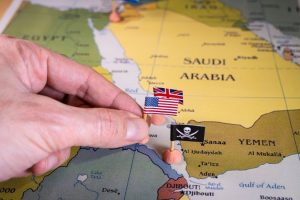 In recent months, the Red Sea has emerged as a point of concern following ongoing incidents, which began in October last year, leading to significant disruptions along one of the globe’s busiest marine passages. The disturbances are exerting profound effects on global logistics networks, influencing sectors like the automotive and oil realms. Officially labelled a ‘crisis’, the turbulent region is impacting a wide range of vessels, such as petroleum tankers, freight containers and liquid natural gas (LNG) transports. The extent of the damage of these hostilities actually surpasses the initial impacts endured during the pandemic’s onset, with only the blockage caused by the Ever Given vessel in the Suez Canal for a six-day span in March 2021 having a greater effect [1].
In recent months, the Red Sea has emerged as a point of concern following ongoing incidents, which began in October last year, leading to significant disruptions along one of the globe’s busiest marine passages. The disturbances are exerting profound effects on global logistics networks, influencing sectors like the automotive and oil realms. Officially labelled a ‘crisis’, the turbulent region is impacting a wide range of vessels, such as petroleum tankers, freight containers and liquid natural gas (LNG) transports. The extent of the damage of these hostilities actually surpasses the initial impacts endured during the pandemic’s onset, with only the blockage caused by the Ever Given vessel in the Suez Canal for a six-day span in March 2021 having a greater effect [1].
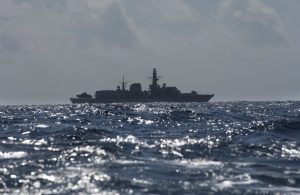 The latest Houthi attacks have escalated and diverse methods, including drones, boats, helicopters, and projectiles, are targeting commercial craft. Notably, the US-owned Genco Picardy bulk carrier suffered a drone strike in the Gulf of Aden around mid-January. Later in the month, two cargo ships transporting US military equipment came under attack from three anti-ship missiles near the Bab el-Mandeb Strait [2], necessitating intervention by accompanying US Navy forces. As part of Operation Prosperity Guardian, a coalition effort led by the US and involving the UK, Bahrain, Canada, France, Italy, the Netherlands, Norway, the Seychelles, and Spain [3], naval units have actively engaged in escorting at-risk watercraft, intercepting threats, and neutralising airborne hazards.
The latest Houthi attacks have escalated and diverse methods, including drones, boats, helicopters, and projectiles, are targeting commercial craft. Notably, the US-owned Genco Picardy bulk carrier suffered a drone strike in the Gulf of Aden around mid-January. Later in the month, two cargo ships transporting US military equipment came under attack from three anti-ship missiles near the Bab el-Mandeb Strait [2], necessitating intervention by accompanying US Navy forces. As part of Operation Prosperity Guardian, a coalition effort led by the US and involving the UK, Bahrain, Canada, France, Italy, the Netherlands, Norway, the Seychelles, and Spain [3], naval units have actively engaged in escorting at-risk watercraft, intercepting threats, and neutralising airborne hazards.
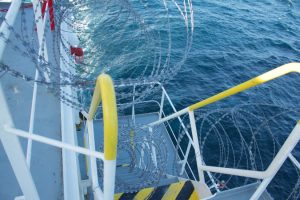 Alongside footage depicting seafarers taking precautionary steps in previous high-seas robberies – for example, securing the deck with razor wire, utilising water cannons to flood rogue boats and impede manoeuvrability, and strategic placement of dummies to create the illusion of a larger crew on watch – technology also serves as a deterrent against hijacks. The surge in Somali pirate events in the early 2000s led to the deployment of various devices aboard potential targets and, with reports indicating the resurgence of Somali pirates [4], in addition to the present situation in the Red Sea, we anticipate a growing adoption of protective measures to deter and repel unauthorised commandeering scenarios.
Alongside footage depicting seafarers taking precautionary steps in previous high-seas robberies – for example, securing the deck with razor wire, utilising water cannons to flood rogue boats and impede manoeuvrability, and strategic placement of dummies to create the illusion of a larger crew on watch – technology also serves as a deterrent against hijacks. The surge in Somali pirate events in the early 2000s led to the deployment of various devices aboard potential targets and, with reports indicating the resurgence of Somali pirates [4], in addition to the present situation in the Red Sea, we anticipate a growing adoption of protective measures to deter and repel unauthorised commandeering scenarios.
How Does Tech Detect, Monitor, and Prevent Piracy?
With over 20 members involved in the Operation Prosperity Guardian alliance, several solutions are combating challenges in the Red Sea. Despite the array of technologies, questions are arising about the absence of more sophisticated techniques like laser applications. According to Vice Adm. Brendan McLane, Commander of Naval Surface Forces, in a Navy Times article, lasers could effectively counter Houthi bombardments. The piece highlights the limited implementation of laser capabilities on only a few vessels, proposing that high-energy lasers (HELs) and high-power microwaves (HPMs) would enhance the fleet’s ability to confront dangers above, like unmanned aerial vehicles and rockets [5]. A corresponding BBC story discusses BAE Systems’ development of a laser-based device capable of warning pirates up to 2000m away or dazzling them at closer ranges. However, it clarifies that no such BAE products are currently in use [6].
 In September, before the start of the Red Sea turmoil, Singaporean tech firm Zycraft diversified its endeavours to develop a laser-based tool using LiDAR (light detection and ranging) sensors as an “off-the-shelf” method for combating sea crime [7]. The solution aims to identify approaching pirate boats, providing the personnel with preliminary warnings and an opportunity to respond proactively. These abilities enable it to discern minute objects at sea, such as a ‘floating piece of rope’, even in adverse weather conditions. Moreover, it can spot the wake left by vessels [7].
In September, before the start of the Red Sea turmoil, Singaporean tech firm Zycraft diversified its endeavours to develop a laser-based tool using LiDAR (light detection and ranging) sensors as an “off-the-shelf” method for combating sea crime [7]. The solution aims to identify approaching pirate boats, providing the personnel with preliminary warnings and an opportunity to respond proactively. These abilities enable it to discern minute objects at sea, such as a ‘floating piece of rope’, even in adverse weather conditions. Moreover, it can spot the wake left by vessels [7].
Not only are cargo ships susceptible to piracy, but yachts, too, have fallen prey to maritime criminal activities. The allure of these luxury vessels makes them attractive targets for thieves, meaning they demand robust protection against on-board thefts. In the realm of nautical security, thermal imaging emerges as a crucial safeguard, particularly in low-light conditions. Teledyne FLIR, a trusted provider in the domain, underscores the efficacy of its high-resolution thermal sensors paired with extended-range zoom lenses.
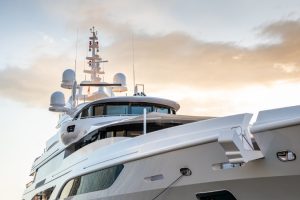
Advanced features, such as automatic surveillance mode, contribute to ensuring constant vigilance for captains and crew alike and integration with a compatible radar system elevates the defence mechanism by enabling the establishment of guard zones which, when synchronised with the radar, autonomously confirm expected vulnerabilities and seamlessly relay tracking information to the camera. This synergy creates a hands-free advance notification procedure, enhancing the overall security posture and fortifying shipowners from attacks.
Charting a Technological Course: The Future of Anti-Piracy Endeavours
As the maritime community faces a persistent threat of piracy, the integration of optical technologies stands as a guiding light of expertise in the continuous struggle against criminal activities. The recent upheavals in the Red Sea underscore the urgent need for advanced solutions, particularly laser-based systems. The limited deployment of such technologies, as highlighted, sparks questions about their underutilisation in countering Houthi bombardments.
These lasers have emerged as frontline protection, offering early warnings and proactive measures against potential pirate incursions. The notable case of Zycraft’s LiDAR tool demonstrates the viability of such solutions in combating sea crime. These systems, with their ability to identify approaching threats, create a paradigm shift in maritime security, equipping shipowners and other forces with indispensable tools to safeguard against the evolving tactics of pirates.
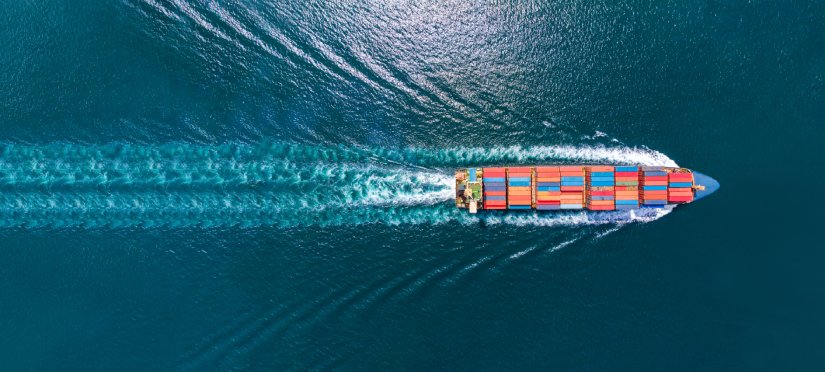
Looking ahead, the future of anti-piracy technology holds promising possibilities. Advancements in high-energy lasers (HELs) and high-power microwaves (HPMs) are poised to revolutionise the defence mechanisms against airborne threats, and the integration of on-spec optical components helps to elevate the situational awareness and response capabilities to unprecedented levels that these systems boast.
In conclusion, the synergy between optics and anti-piracy technologies marks a transformative era in maritime security, and the incorporation of laser-based systems and other optical-focused innovations not only addresses current vulnerabilities but also sets the stage for a more robust, proactive, and technologically advanced fortification against the complex challenges posed by modern-day piracy.
As we navigate our current troubled waters, optical tech emerges as a pivotal force, illuminating the path towards a safer and more secure future at sea.
FOOTNOTES:
[2] https://www.theguardian.com/world/2024/jan/24/us-navy-cargo-ships-houthi-missile-attack-yemen
[4] https://euobserver.com/opinion/157956
[7] https://maritime-executive.com/article/singaporean-tech-firm-uses-lasers-to-spot-pirates
